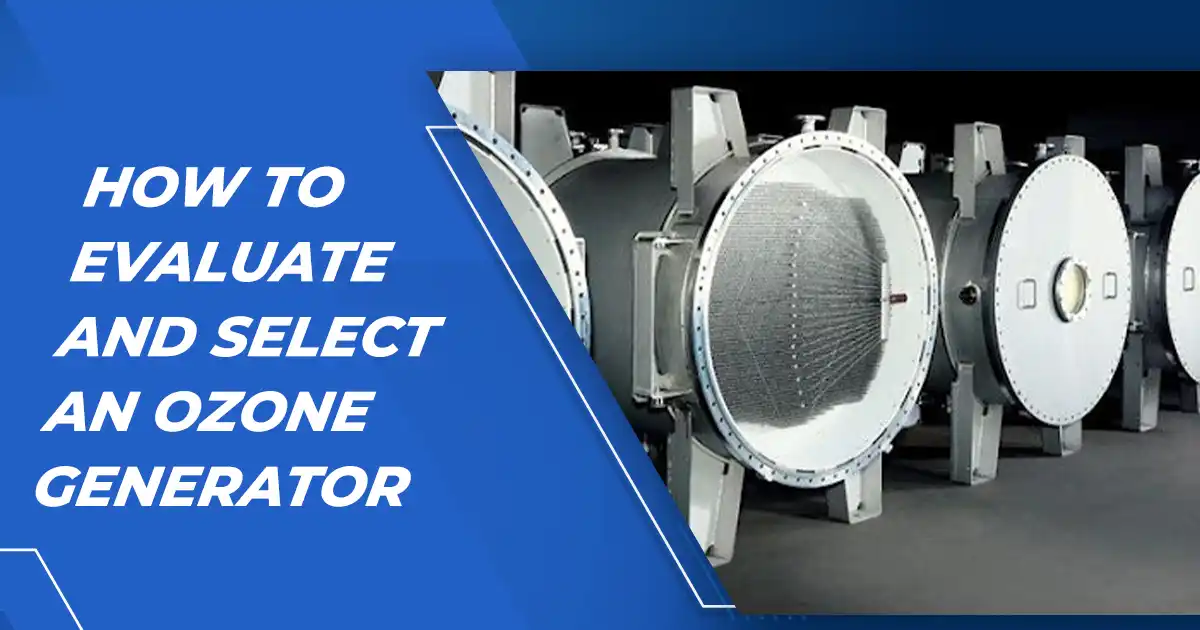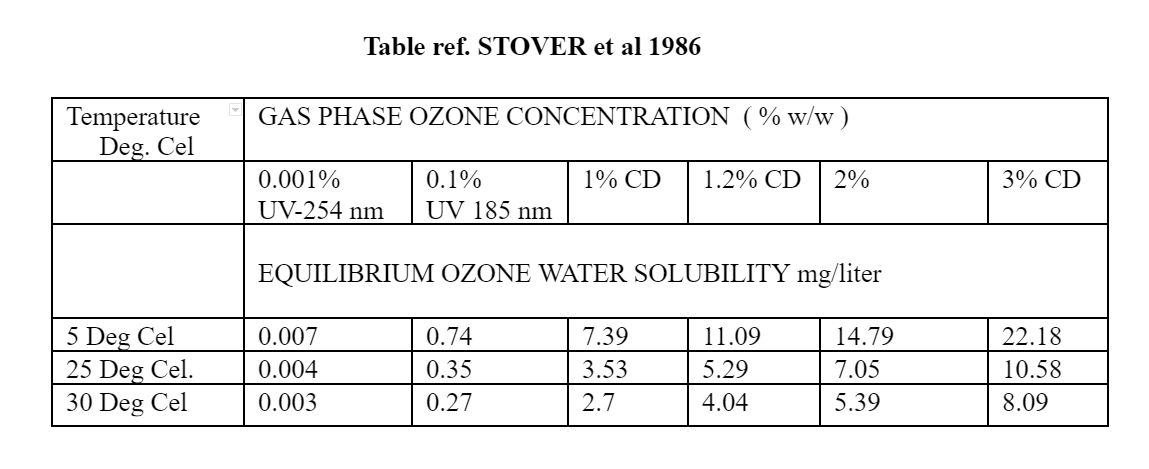How To Evaluate And Select An Ozone Generator
Posted on: April 26, 2023
HOW TO EVALUATE AND SELECT AN OZONE GENERATOR

Awareness of ozone and its applications in India have increased. With more stringent rules with respect to the environment, consultants have begun to look to alternate technologies and have found ozone providing solutions to many of their problems. As this technology is relatively new, it becomes very important for consultants and prospective users to be aware of the intricacies associated with this technology.
Ozone is an effective technology as long as it is applied well. For a successful Ozone application, four vital aspects are to be borne in mind. They have to be understood, analyzed and then the decision can be taken. The three aspects to be considered are:
- The Ozone generation technology – Ozone can be generated from air through UV technology or Corona discharge technology, but also directly from water using electrolytic membranes. The selection of technology will greatly affect the success of the application. The Ozone generation technology also determines the Ozone concentration produced by the Ozone generator.
- The running costs of an Ozone generator- The running costs of an Ozone generator depends on the choice of feed gas, the type of cooling and hardware design which also affects the maintenance costs over time.
- Safety Aspects – Never neglect this aspect. Though ozone is a safe gas when handled well , the equipment uses high power , and needs to have interlocks for protection .The lifespan of the equipment and maintenance requirement depends upon this factor .Operational safety should also be ensured
In most cases, clients and consultants are often in the dark as to how they go about evaluating ozone systems and the criteria to select the equipment for their applications.
The article will attempt to simplify the process of selections so that the user and the consultant make an informed decision to arrive at the selection.
CONSIDERING THE OZONE TECHNOLOGY
Ozone can be produced in over a 100 ways. There are more than 700 patented ways of ozone production. But commercially four most popular methods are being used.
- The UV method of ozone production
- The plate types corona Ozone production
- The tube types corona Ozone production
- Electrolytic (PEM) water based Ozone production
THE UV METHOD OF OZONE GENERATION
To understand this we need to define the role of Ozone.
The role of Ozone:
The main purpose of Ozonation is of dual nature. Ozone is expected to perform both Oxidation and disinfection. (Oxidation to remove organics and inorganic contaminants and disinfection to kill bacteria etc). Irrespective of the amount of ozone generated per hour, a minimum concentration of at least 1% is required for both oxidation and disinfection. UV ozone generators cannot generate Ozone at this concentration to perform simultaneous oxidation and disinfection. Ozone concentration greatly affects mixing efficiency.
The concentration of Ozone:
Corona discharge Ozone Generators can produce Ozone at a concentration ranging from 1 to 16% w/w compared to 0.1 to 0.001% w/w by UV ozone. This as mentioned is 10 to 1000 times less when compared to CD ozone generators. The amount of air required for UV Ozone generators is 10 times more than that required for CD units with consequent low Ozone concentrations.
The solubility of Ozone in water is only partial and is governed by Henry’s Law ( the solubility of the gas in water is directly proportional to its partial pressure in the gas phase ) . Consideration of Henry’s Law lead to the obvious conclusion that the higher the Ozone concentration the greater will be the solubility of ozone in water. The more ozone is dissolved in water the more effective it is as a disinfectant. It is therefore very clear that Ozone generated through UV radiation, not much of Ozone is available in the water for both Oxidation and disinfection. The following table explains:

UV lamps used
Most UV Ozone generators available today use 254 manometers (nm ) radiation. 89% of relative spectral energy of UV lamps are at 254 nm, and low of 218 nm. Maximum production of UV ozone occurs at 260 –265 nm. Hence by using 254 nm UV bulbs, it is impossible to produce more than traces of Ozone.
Chicks law
The disinfection process of ozone is governed by Chicks law. This law follows the CT Factor more commonly known as Contact time factor. Just as antibiotics used have specific doses for different strains of Bacteria , and the minimum inhibitory concentration of that particular antibiotic in the blood will decide on the efficacy of the antibiotic, Ozone also has different CT factors for bacteria / virus etc. Therefore for effective Ozonation, CT levels are to be maintained if full benefits are to be achieved.
Therefore the concentration/ and time factor is the most important in ozone ozone disinfection, both of which are not achievable with UV ozone.
Air-borne Bacteria/ viruses are more easily destroyed by ozone than water borne organisms. This is the precise reason why for air treatment ozone requirement is so very low.
Mechanism of action
This is the most important difference. The ozone generated by UV ozone is immediately decomposed by UV radiation to form free Hydroxyl radicals. In aqueous solutions these Hydroxyl free radicals (OH+) are very powerful oxidizing agents. But the greatest disadvantage is that the half-life of these Hydroxyl radicals is in the order of MICROSECONDS compared to 22 minutes of Ozone. Consequently Ozone Generated by UV method cannot be expected to remain in solution for sufficient period of time to provide adequate disinfection, although chemical oxidation can occur. As a result UV produced Ozone is only remotely effective when it comes to air sterilization.
PLATE TYPE CORONA DISCHARGE METHOD OF OZONE GENERATION
The plate type Technology was first developed in Russia and has now been considered outdated. All over the world this plate type Technology has been superseded by the tube technology due to the following reasons:
The plates are usually connected to the high voltage wires by means of alloy solder. During the course of the Corona discharge formation, the system is at a very high-energy state and resulting in significantly high temperature. This combination creates weakness in the solder and together with the reaction with the ozone produced at the critical phase, the joints break-up within a short time causing generator failure.
The other factor is that when air is passed through the parallel plates, the small width of the space between the plates would increase the resistance to the airflow that only a portion of the air is available for Ozone production
It is a known fact that metals can accumulate dust because of electrostatic conditions. In air sanitization where plate type generators are mostly used, even with the best of filters, if one examines the air conditioning duct after months of operation, heavy dust build-up could be observed. This dust build-up attracts moisture on the corona plate .The dust also accumulates. This will result in failure of the cell if they are not cleaned regularly. The maintenance of the plate is very cumbersome and risky
The plate types of generators allow air to pass between two or more parallel plates with alternating negative and positive charges. The corona between the plates will generate the Ozone. Where the application uses air as feed gas the pre-treatment of the feed gas becomes very vital. Air quality must be at least Minus 60 degrees Dew Point to prevent formation of Nitrous oxides due to ozone reactions with moisture and Nitrogen present in the air. This may not be a problem in very small-scale applications but becomes a very big factor in large applications.
However this problem of Nitrous acid formation can be avoided in plate type systems by using oxygen as feed gas. So for applications where air feed is sufficient, plate type technologies are found to be expensive
There have been some improvements in plate type Ozone generators recently that has resulted in improved performance, but the technology is still largely considered as inferior to tube type generation for large commercial applications
THE TUBE TYPE CORONA DISCHARGE OZONE GENERATION
This is by far the most common and the most widely used method. This is the latest and the most reliable technology. The technology consists of a di-electric that could be glass /SS combination or Ceramic. Air /Oxygen as feed gas is passed through the minute gap between the dielectric and a high voltage applied. The ionization of oxygen takes place within this gap and ozone is formed.
The quantity of ozone formed with this Technology depends on the Technology used to generate high voltage .Ozone can be formed at concentrations between 6-16 % using this Technology. Most of the large ozone companies around the world use this technology and have continuing research to improve and make the technology more economical and better efficiency. For very large applications this technology provides the most economical way to produce ozone. Ozone produced by this method can be anywhere up to 40% more economical when compared to the plate type Corona ozone Systems

ELECTROLYTIC OZONE GENERATION
Electrolytic ozone generators offer a consistent, cost-effective solution for continuous or discrete disinfection of cold storage and distribution systems for ultrapure water (systemic protection). The key advantage of this mechanism is that it is a straightforward and simple process of water electrolysis, that is the ozone is generated directly from the water. The design that allows reliable and fully automatic operations along with low maintenance. The applications it serves span across – PW (Purified water), HPW (High purified water), and WFI (Water for injection). Only a small amount of Ozone is generated using this technology, and the efficiency depends largely on the conductivity of the water and thus its application is limited to pure water only.
RUNNING COSTS OF AN OZONE GENERATOR
The variable factors of ozone production can be classified into:
a). Feed Gas – Choice of feed Gas – Air Or Oxygen
b). Power consumption for ozone production
c). Cooling system – Air cooled or water Cooled ozone generators
d). Maintenance costs of the ozone system
The first three forms what is known as the THREE PILLARS OF OZONE GENERATION
CHOICE OF FEED GAS
The choice of feed gas will determine the running cost of the ozone system. Whether to use Air or Oxygen as feed gas will depend on the application needs. Applications that need high concentration ozone will require the use of oxygen as feed gas. This is because as air Contains only around 21% oxygen, the concentration of ozone produced with air will never exceed 3-5% w/w , whereas with oxygen a concentration of upto 16 % can be used . Some of the High concentration applications are: Paper and Pulp, COD and Color Reduction ,disinfection and Ozonolysis. Other applications such as potable water treatment, process water, and municipal water treatment can use air as feed gas though in most cases oxygen is recommended here as well .Chemical reactions of ozone are not governed by ozone concentrations. Choice of right concentrations will however help in ozone mass transfer (cost of application) and help reduce cost of accessories.
Air as the feed gas
When air is used as feed gas, the cost of application is determined by
- Capital costs of air compressor, Air driers and filters
- Running costs of air compressors and air driers
- Maintenance costs of air compressor systems
- Costs of ozone mass transfer
While using Air as feed gas, one should remember that the size of the ozone systems would be large. The cost of ozone mass transfer will affect the cost of application. Due to the volume of the gas involved in such applications, the hydro-injector system, the diffuser systems, the injector pumps have all to be sized accordingly, affecting the overall capital costs.
The technology of the ozone generating system will also determine the volume of air required for a specified ozone production. Good ozone generators require less air for producing the same weight of ozone, thereby bringing about a lower capital and subsequent running costs.
Oxygen as Feed Gas
Using oxygen means using a smaller ozone generator (Reduced capital costs) since the same ozone generator can produce nearly double the quantity of ozone. The overall costs of ozone mass transfer devices will also be lower since relatively lower volume of gas is being used
When oxygen is considered the choice can be using oxygen by LOX (liquid oxygen supplied in tanks @ Rs 8- 12 per kg of oxygen ) , or oxygen produced through PSA or VSA .The choice between the two will depend on the local costs of liquid oxygen when compared to the investment, running and maintenance costs of a PSA system
When using oxygen as feed gas, the question of concentration arises. By using oxygen the concentration of Ozone obtained would be anywhere from 6-14%. Selecting a particular concentration would depend on the following factors
- The application requirement
- The local costs of power – the higher the concentration required, the more power would be required to produce ozone, but the requirement of oxygen will also be less. Lower concentration will involve lower power demand, but higher oxygen demand. So the total running costs have to be compared and the best alternative selected
POWER CONSUMPTION OF OZONE SYSTEM
Ozone production is a consequence of high voltage applied across a dielectric. The energy splits the oxygen molecules to atoms that recombine to form some ozone .Therefore along with oxygen requirement; power is also an important consideration. Research has been done for more than decades to produce ozone with lower power. Today very good technologies are available that produce ozone with lower power. A good ozone generator should be able to produce 1 gram of ozone with about 8 watt of power or less .The higher the power applied, the more ozone is produced and the smaller the sizes of the equipment .
Ozone produced from Air may require up to 15 Watts per gram of ozone as the power costs of air compression has to be included in the cost of ozone production.
COOLING SYSTEM
During ozone production, a lot of heat is produced. The heat produced has to be removed as and when it is generated to avoid loss of ozone and equipment damage due to heat. Most ozone generators have cooling/chilled water circuits for their di-electric to remove this heat. Small applications that require small ozone generators – up to 20 grams are normally air cooled. It is the larger ozone systems that require cooling/chilled water circuits. The amount of chilled/cooling water required will depend on the heat load. This is where technology plays an important part. Sophisticated technologies are available today where the heat generated during ozone production is limited, thereby requiring low chilled water requirement. Ozone can also be used in cooling towers, it can be either air-cooled or water-cooled, and the excess heat must be safely removed from the corona cell as ozone.
MAINTENANCE COST OF AN OZONE GENERATOR
These are normally missed by the client. Maintenance costs can sometimes be very high
Dielectrics are most often the culprits. Dielectrics are exposed to high voltage and heat. The electrical stress often produces failures that require change in di-electrics. The cost of this change can affect the maintenance costs, the machine downtime and productivity. Longevity of the cells is often linked to the construction of the tubular cells and the technology used. Type of air feed preparation can greatly affect the Ozone generator maintenance cost as well.
The breakdown voltage of the dielectrics should be at least 75% more than the voltage applied across the dielectrics .This will ensure that the the dielectric withstands the electrical stress involved and prevent failures
The other components such as transformers, inverters, chokes, may also come in for maintenance if the quality of these are not up to the mark.
Plate type ozone generators are more problematic to maintain. Because the corona plates offer a large surface area, they are more prone to dust accumulation, attacks by nitrous acid formation, and subsequent cell failures. It is precisely for this reason that this technology has become obsolete favoring the tube technology instead.
SAFETY INTERLOCKS
For all Industrial applications this is an important consideration. The entire system must be considered safe including operations. The presence of safety interlocks can protect the equipment, as well as the operator
Look out for the following safety features
1. Protection against High and low pressures of feed gas
Too low pressure of oxygen can lead to lower Ozone production and increased changes of water backflow. Too high Ozone pressure can lead to damage of Ozone electrodes
2. Protection against poor quality feed gas
High dew point can damage the Ozone electrode in months, while low purity can reduce Ozone production. Low flow can lead to higher Ozone concentration than intended while higher flow can lead to poor mixing as the mixing systems are often designed based on a particular flow. Purity and dew point sensors are mandatory.
3. Protection against high cooling water temperatures and low cooling water flow
High cooling water temperature can reduce Ozone production and can also cause Ozone electrode damage, while low cooling water flow can lead to insufficient cooling ,lower Ozone production and Ozone electrode damage. Cooling water flow transmitter and temperature sensor/transmitters are mandatory
4. Protection against High transformer temperatures
Cooling of transformers and temperature measurement within the Ozone cabinet is important to protect the Ozone transformer as this is the only equipment that generates heat inside the Ozone panel.
5. Protection against Ozone and oxygen leaks
Calibrated Leak detectors for Ozone and oxygen need to be installed in areas where the possibility of Ozone and Oxygen leakages are high. Usually these are near the feed gas systems, Ozone generator systems and Ozone contact tanks
6. Requirement of off- gas treatment – Ozone Destructors
Unreacted Ozone from tanks needs to be safely vented into the atmosphere. Ozone destructors are mandatory in any Ozone application.
7. Protection against water backflow
Safety valves, water traps and higher feed gas pressure often reduce the change of backflow prevention. Any backflow of water into the Ozone generator can lead to catastrophic failure.
6 comments

Shreyas Baratharaj | Director
Sheryas Barathraj has over 15 years of experience in municipal and industrial ozone applications. He has worked on some of the world’s largest ozone installations, with key interests in advanced oxidation, chemical synthesis, pharmaceutical water systems, and municipal drinking water treatment. LinkedIn Bio ›



https://shorturl.fm/6qZr4
https://shorturl.fm/7qx6Z
https://shorturl.fm/uTwCe
https://shorturl.fm/1Q1ig
https://shorturl.fm/nCspA
https://shorturl.fm/bt7nx